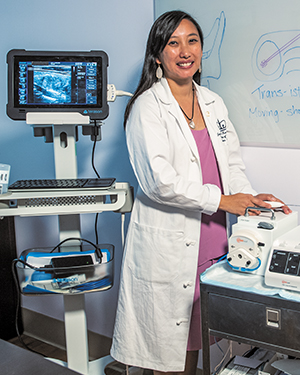
Dr. Jennifer Kuo
“The vast majority of the 130,000 thyroidectomies performed each year in the United States are on patients with benign thyroid nodules, and until recently, all we could offer them was this surgery,” says Jennifer H. Kuo, MD, MS, Director of the Interventional Endocrinology Program and Endocrine Surgery Research Program at NewYork-Presbyterian/Columbia University Irving Medical Center. “Although generally considered a low risk procedure associated with good outcomes, there can be side effects and, less commonly, concerning complications that include hematoma, decreased parathyroid hormone activity, as well as nerve injury. In addition, 25 to 30 percent of these patients will require thyroid hormone supplementation at some point in their lifetime.”
“Thyroidectomy is a straightforward operation, but it is still an operation,” continues Dr. Kuo. “Patients are increasingly finding surgery disconcerting – we’re removing a perfectly healthy, perfectly functional organ that is not cancer. The question is: Is there a way to effectively treat growing thyroid nodules in a way that also allows us to preserve the thyroid gland?”
An international expert in ultrasound-guided radiofrequency ablation (RFA) of thyroid nodules, Dr. Kuo is leading the U.S.-based efforts to expand and popularize patient options for alternative, minimally invasive treatments, such as RFA, which shrinks the nodules through ablation as the body reabsorbs the ablated tissue. While RFA of thyroid nodules was introduced in South Korea in 2002 and quickly gained popularity as a treatment option throughout Asia and Europe, there is limited experience with this procedure in the United States.
The Thyroid Cancer Survivors’ Association and the American Thyroid Association have taken notice of Dr. Kuo’s research, awarding her support for three clinical trials to rigorously evaluate clinical outcomes of RFA of thyroid nodules.
As Dr. Kuo, an endocrine surgeon and surgeon-scientist, and James A. Lee, MD, Chief of Endocrine Surgery and Co-Director of the New York Thyroid-Parathyroid Center at NewYork-Presbyterian/Columbia, outline in their article published in the January 1, 2021, issue of Annals of Surgery, RFA of thyroid nodules offers several relative advantages to thyroidectomy:
- Ability to perform the procedure in an office-based setting without general anesthesia
- Reduced cost when compared to operating room-based procedures
- Less invasive profile than surgery
- Shorter recovery time
- Lack of visible scar
- Vastly reduced risk of hypothyroidism
“RFA provides a good balance between efficacy and well-being,” says Dr. Kuo, emphasizing that, as with any new technology or therapy, patients are best served by a cautious and judicious adoption process that prioritizes safety and excellent outcomes. “You have to counsel patients appropriately so they understand their disease and the long-term consequences of any intervention in order to help them make an informed decision.”
“The radiofrequency ablation is performed under ultrasound guidance,” explains Dr. Kuo. “The patient is awake and under local anesthesia only, talking to you and able to swallow, so your target is not stationary. Therefore, the intervention is not stationary and the approach is dynamic and performed freehand. You can imagine that the level of eye-hand coordination needed is significant. The electrode is constantly moving as we are actively ablating. You want to apply enough power to achieve a thorough ablation and cause the coagulative necrosis, but not too much where you would start to have thermal spread and cause injury.”
The Thyroid Cancer Survivors’ Association and the American Thyroid Association have taken notice of Dr. Kuo’s research, awarding support for three clinical trials to rigorously evaluate clinical outcomes of RFA of thyroid nodules. The trials, which began in 2019 and are ongoing through 2024, evaluate:
- Patients with benign solid nodules who undergo RFA, as compared to those who opt for surgical resection to determine differences in quality-of-life measures
- Outcomes of patients with papillary microcarcinomas – or papillary thyroid cancers less than 1.5 centimeters in size – who undergo RFA as compared to those who undergo active surveillance
- Outcomes of patients with indeterminate thyroid nodules – specifically Bethesda classification – that have been classified benign, and who undergo RFA, as compared to those who choose surgical resection or active surveillance
Preliminary results are impressive and abstracts are forthcoming. As of May 2022, approximately 200 patients have undergone RFA at NewYork-Presbyterian/Columbia. Dr. Kuo believes that the biggest motivator for patients is the ability to preserve thyroid function by avoiding exogenous hormone replacement and medication.
“We are fortunate our program was up and running prior to the COVID-19 pandemic, as we’ve had exponential growth in interest over the last few years. Currently, these procedures encompass about 40 percent of my practice, whereas it was zero percent just three years ago,” says Dr. Kuo.
Given patient awareness and two decades of international research, Dr. Kuo and Dr. Lee undertook an analysis to better understand the slow pace of adoption of the procedure in the United States through a social-cultural lens using EM Rogers’ Diffusion of Innovation Theory. The theory recognizes that the adoption process generally takes place over many years, with an initial slow rate of adoption often giving way to a rapidly accelerating rate. According to Rogers’ paradigm, current adopters of RFA in the United States are likely considered Early Adopters. Although they did not create the innovation, they are comfortable adopting RFA because they believe in its potential.
“We are at the tipping point on RFA to treat thyroid nodules,” says Dr. Kuo. “We as surgeons, in particular, have an opportunity to take on the mantle for RFA. It is certainly exciting to be in the forefront of these innovations to determine how they will have the most meaningful impact.”



